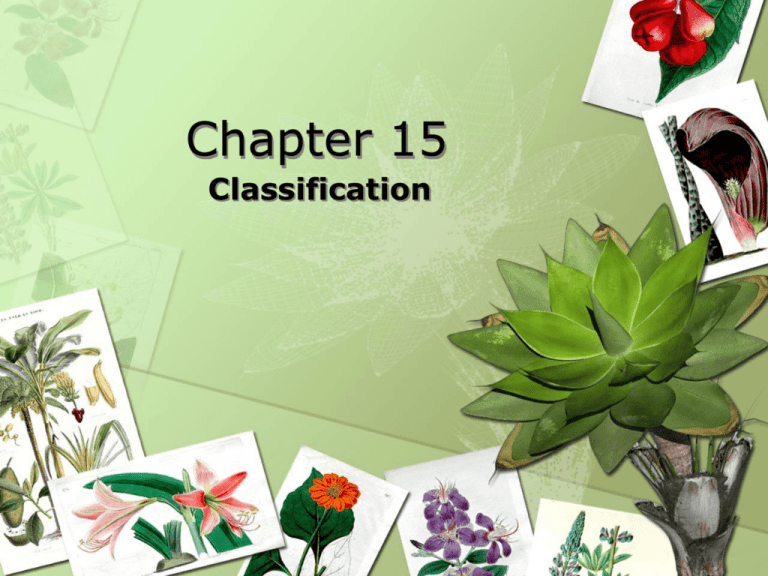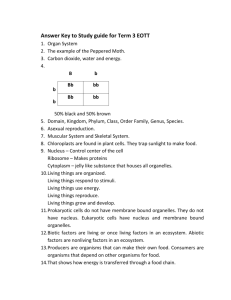Chapter 15
advertisement

Chapter 15 Classification History of Taxonomy Taxonomy • The branch of biology that names and groups organisms according to their characteristics and evolutionary history • Organisms were first classified more than 2,000 years ago by Aristotle • Grouped as plants or animals Linnaeus’s System • Swedish naturalist Carolus Linnaeus (1707-1778) – devised a system of grouping organisms into hierarchical categories • He used an organisms form and structure (morphology) to classify it Levels of Classification • Devised a nested hierarchy of seven different levels of organization • Kingdom (largest), phylum (division in plants), class, order, family, genus, species (smallest) • Taxa – each hierarchical division Domain Eukarya Kingdom Animalia Phylum Chordata Class Mammalia Order Carnivora Felidae Family Genus Lynx Species Lynx rufus Bobcat Lynx canadensi s Lynx Taxonomic rankings • Compare the appearance of a lynx, Lynx rufus, a bobcat, Lynx canadensis, and a mountain lion, Panthera concolor. Lynx Bobcat Mountain lion Binomial Nomenclature • Two part name system – in Latin – universal • The species name (scientific name) has two parts • Genus species • Ex. Homo sapiens How they are classified • Taxonomists consider the phylogeny (evolutionary history) of the organism Modern Taxonomists consider: • Morphology • Chromosomal characteristics • Nucleotide sequences • Amino acid sequence • Embryological development Chromosome comparisons • For example, cauliflower, cabbage, kale, and broccoli look different but have chromosomes that are almost identical in structure. Phylogenetic Tree • A family tree that shows the evolutionary relationship thought to exist among groups of organisms The Fossil Record • Often provided clues to evolutionary relationships Morphology • Taxonomists study an organism’s morphology and compare it with the morphology of other living organisms Embryological Patterns of Development • Early patterns in embryological development provides evidence of phylogenetic relationships Chromosomes and Macromolecules • Taxonomists use comparisons of macromolecules such as DNA, RNA and proteins as a kind of “molecular clock” • Biologists compare the karyotypes, or patterns of chromosomes, of two related species – regions that are the same are clues to the degree of relatedness of organisms Six-Kingdom System 1. Find three ways to group these animals 2. What characteristics did you use for each classification? • The five kingdom system was used for years but recently it was determined that there are two important subtypes with very different morphologies and properties Kingdom Archaebacteria • Unicellular prokaryotes with distinctive cell membranes as well as biochemical and genetic properties that differ from all other kinds of life • Some species are autotrophic, producing food by chemosynthesis • Chemosynthesis – the production of carbohydrates through the use of energy from inorganic molecules instead of light • Many live in harsh environments • ex,. Sulfur hot springs, salty lakes, anaeorbic • Archae – “ancient” Kingdom Eubacteria • Eu = “true” • Unicellular prokaryotes • Most use oxygen • Germs Kingdom Protista • Mostly single-celled organisms • Lack specialized tissues • Membrane-bound true nucleus with linear chromosomes and they have membrane bound organelles • Eukaryotes Kingdom Fungi • Made of heterotrophic unicellular and multicellular eukaryotic organisms • Absorb nutrients rather than ingesting them the way some protists do • 100,000 species • Ex. mushrooms Kingdom Plantae • Multicellular plants • Autotrophic and use photosynthesis • Live on land • Have a sexual cycle based on meiosis • 350,000 species • Mosses, ferns, conifers, flowering plants Kingdom Animalia • Eukaryotic, multicellular heterotrophic organisms • Symmetrical body organization • Standard sexual cycle that employs meiosis The End







